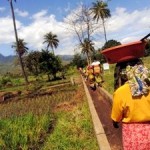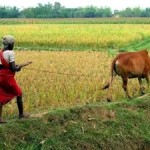 Geneva, Switzerland – Farming in rich and poor nations alike should shift from monoculture towards greater varieties of crops, reduced use of fertilizers and other inputs, greater support for small-scale farmers, and more locally focused production and consumption of food, a new UNCTAD report recommends.
Geneva, Switzerland – Farming in rich and poor nations alike should shift from monoculture towards greater varieties of crops, reduced use of fertilizers and other inputs, greater support for small-scale farmers, and more locally focused production and consumption of food, a new UNCTAD report recommends.
The Trade and Environment Report 2013 warns that continuing rural poverty, persistent hunger around the world, growing populations, and mounting environmental concerns must be treated as a collective crisis. It says that urgent and far-reaching action is needed before climate change begins to cause major disruptions to agriculture, especially in developing countries.
The report, subtitled “Wake Up Before It Is Too Late: Make Agriculture Truly Sustainable Now for Food Security in a Changing Climate”, was released on September 18. More than 60 international experts contributed to the report’s analysis of the topic. The study notes that the sheer scale at which production methods would have to be modified under these proposals would pose considerable challenges. In addition, it would be necessary to correct existing imbalances between where food is produced and where it is needed, to reduce the power asymmetries that exist in agricultural input and food-processing markets, and to adjust current trade rules for agriculture.
The Trade and Environment Report 2013 recommends a rapid and significant shift away from “conventional, monoculture-based… industrial production” of food that depends heavily on external inputs such as fertilizer, agro-chemicals, and concentrate feed. Instead, it says that the goal should be “mosaics of sustainable regenerative production systems that also considerably improve the productivity of small-scale farmers and foster rural development”. The report stresses that governments must find ways to factor in and reward farmers for currently unpaid public goods they provide – such as clean water, soil and landscape preservation, protection of biodiversity, and recreation.
Climate change will drastically impact on agriculture, the report forecasts, primarily in the developing regions with the highest future population growth, such as sub-Saharan Africa and South Asia. Much slower agricultural productivity growth in the future and fast-rising populations in the most vulnerable regions will almost certainly worsen current problems with hunger, drought, rising food prices, and access to land. These pressures may easily lead to massive migrations, and to international tensions and conflicts over food and resources such as soil and water.
The report cites a number of trends that collectively suggest a mounting crisis:
- Food prices from 2011 to mid-2013 were almost 80 per cent higher than for the period 2003–2008;
- Global fertilizer use has increased by eight times over the past 40 years, although global cereal production has only doubled during that period;
- Growth rates in agricultural productivity have recently declined from 2 per cent per year to below 1 cent;
- Two types of irreparable environmental damage have already been caused by agriculture: nitrogen contamination of soil and water, and loss of biodiversity;
- Greenhouse gas emissions from agriculture are the single biggest source of global warming in the South. They also the fastest growing (along with emissions from transport);
- Foreign land acquisition in developing countries (often termed “land grabbing”) in recent years has amounted, in value, to between five and ten times the level of official development assistance.
But most important of all are the persistent problems with hunger, malnutrition, and access to food. Almost 1 billion people currently suffer from hunger, and another 1 billion are malnourished, the report notes, even though current global agricultural production already provides sufficient calories to feed a population of 12 to 14 billion. Some 70 per cent of the hungry or malnourished are themselves small-scale farmers or agricultural labourers, indicating that poverty and access to food are the most critical challenges.
Monoculture and industrial farming methods are not providing sufficient affordable food where it is needed, the report says, while the environmental damage caused by this approach is mounting and is unsustainable. It says that the highest priority must be given to enabling the rural poor to become self-sufficient in food or to earn sufficient income through agriculture so that they can buy food.
The report emphasizes that a shift is necessary towards diverse production patterns that reflect the “multi-functionality” of agriculture and enhance closed nutrient cycles. Moreover, as the environmental costs of industrial agriculture are largely not accounted for, governments should act to ensure that more food is grown where it is needed. It recommends adjusting trade rules to encourage “as much regionalized/localized food production as possible; as much traded food as necessary”.
The past strategy of relying on international markets to meet staple food demand, while specializing in the production and export of “lucrative” cash crops, has recently failed to deliver its desired results, because it has relied on low staple food prices and no shortage of supply in international markets, conditions that have drastically changed since the turn of the century, the report notes. Also, globalization has encouraged high levels of specialization. This has resulted in an increasing scale of production of a smaller variety of crops, and has created enormous cost pressures, the report states. All this has aggravated the environmental crisis of agriculture and has reduced agricultural resilience.
Check the following link to read/download the Full Report:
http://unctad.org/en/PublicationsLibrary/ditcted2012d3_en.pdf
Source: UNCTAD.














